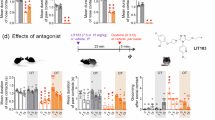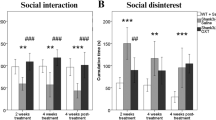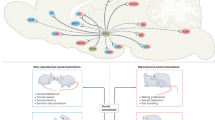Abstract
Intranasal administration of oxytocin (OXT) might be a promising new adjunctive therapy for mental disorders characterized by social behavioral alterations such as autism and schizophrenia. Despite promising initial studies in humans, it is not yet clear the specificity of the behavioral effects induced by chronic intranasal OXT and if chronic intranasal OXT could have different effects compared with single administration. This is critical for the aforementioned chronic mental disorders that might potentially involve life-long treatments. As a first step to address these issues, here we report that chronic intranasal OXT treatment in wild-type C57BL/6J adult mice produced a selective reduction of social behaviors concomitant to a reduction of the OXT receptors throughout the brain. Conversely, acute intranasal OXT treatment produced partial increases in social behaviors towards opposite-sex novel-stimulus female mice, while on the other hand, it decreased social exploration of same-sex novel stimulus male mice, without affecting social behavior towards familiar stimulus male mice. Finally, prolonged exposure to intranasal OXT treatments did not alter, in wild-type animals, parameters of general health such as body weight, locomotor activity, olfactory and auditory functions, nor parameters of memory and sensorimotor gating abilities. These results indicate that a prolonged over-stimulation of a ‘healthy’ oxytocinergic brain system, with no inherent deficits in social interaction and normal endogenous levels of OXT, results in specific detrimental effects in social behaviors.
Similar content being viewed by others
Log in or create a free account to read this content
Gain free access to this article, as well as selected content from this journal and more on nature.com
or
References
Andari E, Duhamel JR, Zalla T, Herbrecht E, Leboyer M, Sirigu A (2010). Promoting social behavior with oxytocin in high-functioning autism spectrum disorders. Proc Natl Acad Sci USA 107: 4389–4394.
Arletti R, Bazzani C, Castelli M, Bertolini A (1985). Oxytocin improves male copulatory performance in rats. Horm Behav 19: 14–20.
Bales KL, Perkeybile AM, Conley OG, Lee MH, Guoynes CD, Downing GM et al (2012). Chronic intranasal oxytocin causes long-term impairments in partner preference formation in male prairie voles. Biol Psychiatry 15: 00800–00801.
Barker GR, Bird F, Alexander V, Warburton EC (2007). Recognition memory for objects, place and temporal order: a disconnection analysis of the role of the medial prefrontal cortex and perirhinal cortex. J Neurosci 27: 2948–2957.
Barker GR, Warburton EC (2011). When is the hippocampus involved in recognition memory? J Neurosci 31: 10721–10731.
Baumgartner T, Heinrichs M, Vonlanthen A, Fischbacher U, Fehr E (2008). Oxytocin shapes the neural circuitry of trust and trust adaptation in humans. Neuron 58: 639–650.
Bielsky IF, Young LJ (2004). Oxytocin, vasopressin and social recognition in mammals. Peptides 25: 1565–1574.
Born J, Lange T, Kern W, McGregor GP, Bickel U, Fehm HL (2002). Sniffing neuropeptides: a transnasal approach to the human brain. Nat Neurosci 5: 514–516.
Braff DL, Geyer MA, Swerdlow NR (2001). Human studies of prepulse inhibition of startle: normal subjects, patient groups, and pharmacological studies. Psychopharmacology (Berl) 156: 234–258.
Buchheim A, Heinrichs M, George C, Pokorny D, Koops E, Henningsen P et al (2009). Oxytocin enhances the experience of attachment security. Psychoneuroendocrinology 34: 1417–1422.
Choleris E, Clipperton-Allen AE, Phan A, Kavaliers M (2009). Neuroendocrinology of social information processing in rats and mice. Front Neuroendocrinol 30: 442–459.
Conti F, Sertic S, Reversi A, Chini B (2009). Intracellular trafficking of the human oxytocin receptor: evidence of receptor recycling via a Rab4/Rab5 ‘short cycle’. Am J Physiol Endocrinol Metab 296: E532–E542.
Ditzen B, Schaer M, Gabriel B, Bodenmann G, Ehlert U, Heinrichs M (2009). Intranasal oxytocin increases positive communication and reduces cortisol levels during couple conflict. Biol Psychiatry 65: 728–731.
Domes G, Heinrichs M, Glascher J, Buchel C, Braus DF, Herpertz SC (2007a). Oxytocin attenuates amygdala responses to emotional faces regardless of valence. Biol Psychiatry 62: 1187–1190.
Domes G, Heinrichs M, Michel A, Berger C, Herpertz SC (2007b). Oxytocin improves ‘mind-reading’ in humans. Biol Psychiatry 61: 731–733.
Ebitz RB, Watson KK, Platt ML (2013). Oxytocin blunts social vigilance in the rhesus macaque. Proc Natl Acad Sci USA 110: 11630–11635.
Feifel D, Macdonald K, Cobb P, Minassian A (2012a). Adjunctive intranasal oxytocin improves verbal memory in people with schizophrenia. Schizophr Res 7: 7.
Feifel D, Macdonald K, Nguyen A, Cobb P, Warlan H, Galangue B et al (2010). Adjunctive intranasal oxytocin reduces symptoms in schizophrenia patients. Biol Psychiatry 68: 678–680.
Feifel D, Shilling PD, Belcher AM (2012b). The effects of oxytocin and its analog, carbetocin, on genetic deficits in sensorimotor gating. Eur Neuropsychopharmacol 22: 374–378.
Ferguson JN, Young LJ, Hearn EF, Matzuk MM, Insel TR, Winslow JT (2000). Social amnesia in mice lacking the oxytocin gene. Nat Genet 25: 284–288.
Gamer M, Zurowski B, Buchel C (2010). Different amygdala subregions mediate valence-related and attentional effects of oxytocin in humans. Proc Natl Acad Sci USA 107: 9400–9405.
Giancardo L, Sona D, Huang H, Sannino S, Manago F, Scheggia D et al (2013). Automatic visual tracking and social behavior analysis with multiple mice. PLoS One 8: e74557.
Green JJ, Hollander E (2010). Autism and oxytocin: new developments in translational approaches to therapeutics. Neurotherapeutics 7: 250–257.
Guastella AJ, Einfeld SL, Gray KM, Rinehart NJ, Tonge BJ, Lambert TJ et al (2010). Intranasal oxytocin improves emotion recognition for youth with autism spectrum disorders. Biol Psychiatry 67: 692–694.
Guastella AJ, Mitchell PB, Dadds MR (2008). Oxytocin increases gaze to the eye region of human faces. Biol Psychiatry 63: 3–5.
Heinrichs M, Baumgartner T, Kirschbaum C, Ehlert U (2003). Social support and oxytocin interact to suppress cortisol and subjective responses to psychosocial stress. Biol Psychiatry 54: 1389–1398.
Heinrichs M, Meinlschmidt G, Wippich W, Ehlert U, Hellhammer DH (2004). Selective amnesic effects of oxytocin on human memory. Physiol Behav 83: 31–38.
Herzmann G, Young B, Bird CW, Curran T (2012). Oxytocin can impair memory for social and non-social visual objects: a within-subject investigation of oxytocin's effects on human memory. Brain Res 1451: 65–73.
Insel TR, Winslow JT, Witt DM (1992). Homologous regulation of brain oxytocin receptors. Endocrinology 130: 2602–2608.
Jin D, Liu HX, Hirai H, Torashima T, Nagai T, Lopatina O et al (2007). CD38 is critical for social behavior by regulating oxytocin secretion. Nature 446: 41–45.
Kirsch P, Esslinger C, Chen Q, Mier D, Lis S, Siddhanti S et al (2005). Oxytocin modulates neural circuitry for social cognition and fear in humans. J Neurosci 25: 11489–11493.
Kumari V, Das M, Zachariah E, Ettinger U, Sharma T (2005). Reduced prepulse inhibition in unaffected siblings of schizophrenia patients. Psychophysiology 42: 588–594.
Landgraf R, Gerstberger R, Montkowski A, Probst JC, Wotjak CT, Holsboer F et al (1995). V1 vasopressin receptor antisense oligodeoxynucleotide into septum reduces vasopressin binding, social discrimination abilities and anxiety-related behavior in rats. J Neurosci 15: 4250–4258.
Lee HJ, Caldwell HK, Macbeth AH, Tolu SG, Young WS 3rd (2008). A conditional knockout mouse line of the oxytocin receptor. Endocrinology 149: 3256–3263.
Lim MM, Bielsky IF, Young LJ (2005). Neuropeptides and the social brain: potential rodent models of autism. Int J Dev Neurosci 23: 235–243.
Ludwig M, Tobin VA, Callahan MF, Papadaki E, Becker A, Engelmann M et al (2013). Intranasal application of vasopressin fails to elicit changes in brain immediate early gene expression, neural activity and behavioral performance of rats. J Neuroendocrinol 25: 655–667.
Macbeth AH, Lee HJ, Edds J, Young WS 3rd (2009). Oxytocin and the oxytocin receptor underlie intrastrain, but not interstrain, social recognition. Genes Brain Behav 8: 558–567.
MacDonald E, Dadds MR, Brennan JL, Williams K, Levy F, Cauchi AJ (2011). A review of safety, side-effects and subjective reactions to intranasal oxytocin in human research. Psychoneuroendocrinology 36: 1114–1126.
Macdonald KS (2012). Sex, receptors, and attachment: a review of individual factors influencing response to oxytocin. Front Neurosci 6: 194.
Meyer-Lindenberg A, Domes G, Kirsch P, Heinrichs M (2011). Oxytocin and vasopressin in the human brain: social neuropeptides for translational medicine. Nat Rev Neurosci 12: 524–538.
Neumann ID (2008). Brain oxytocin: a key regulator of emotional and social behaviors in both females and males. J Neuroendocrinol 20: 858–865.
Neumann ID, Maloumby R, Beiderbeck DI, Lukas M, Landgraf R (2013). Increased brain and plasma oxytocin after nasal and peripheral administration in rats and mice. Psychoneuroendocrinology 38: 1985–1993.
Papaleo F, Crawley JN, Song J, Lipska BK, Pickel J, Weinberger DR et al (2008). Genetic dissection of the role of catechol-O-methyltransferase in cognition and stress reactivity in mice. J Neurosci 28: 8709–8723.
Papaleo F, Yang F, Garcia S, Chen J, Lu B, Crawley JN et al (2012). Dysbindin-1 modulates prefrontal cortical activity and schizophrenia-like behaviors via dopamine/D2 pathways. Mol Psychiatry 17: 85–98.
Popik P, Vetulani J, Van Ree JM (1996). Facilitation and attenuation of social recognition in rats by different oxytocin-related peptides. Eur J Pharmacol 308: 113–116.
Rimmele U, Hediger K, Heinrichs M, Klaver P (2009). Oxytocin makes a face in memory familiar. J Neurosci 29: 38–42.
Sala M, Braida D, Donzelli A, Martucci R, Busnelli M, Bulgheroni E et al (2012). Mice heterozygous for the oxytocin receptor gene (Oxtr(+/−)) show impaired social behavior but not increased aggression or cognitive inflexibility: evidence of a selective haploinsufficiency gene effect. J Neuroendocrinol 11: 1365–2826.
Sala M, Braida D, Lentini D, Busnelli M, Bulgheroni E, Capurro V et al (2011). Pharmacologic rescue of impaired cognitive flexibility, social deficits, increased aggression, and seizure susceptibility in oxytocin receptor null mice: a neurobehavioral model of autism. Biol Psychiatry 69: 875–882.
Scattoni ML, Ricceri L, Crawley JN (2011). Unusual repertoire of vocalizations in adult BTBR T+tf/J mice during three types of social encounters. Genes Brain Behav 10: 44–56.
Scearce-Levie K, Roberson ED, Gerstein H, Cholfin JA, Mandiyan VS, Shah NM et al (2008). Abnormal social behaviors in mice lacking Fgf17. Genes Brain Behav 7: 344–354.
Striepens N, Kendrick KM, Maier W, Hurlemann R (2011). Prosocial effects of oxytocin and clinical evidence for its therapeutic potential. Front Neuroendocrinol 32: 426–450.
Tachibana M, Kagitani-Shimono K, Mohri I, Yamamoto T, Sanefuji W, Nakamura A et al (2013). Long-term administration of intranasal oxytocin is a safe and promising therapy for early adolescent boys with autism spectrum disorders. J Child Adolesc Psychopharmacol 23: 123–127.
Takayanagi Y, Yoshida M, Bielsky IF, Ross HE, Kawamata M, Onaka T et al (2005). Pervasive social deficits, but normal parturition, in oxytocin receptor-deficient mice. Proc Natl Acad Sci USA 102: 16096–16101.
Tribollet E, Barberis C, Arsenijevic Y (1997). Distribution of vasopressin and oxytocin receptors in the rat spinal cord: sex-related differences and effect of castration in pudendal motor nuclei. Neuroscience 78: 499–509.
Veening JG, Olivier B (2013). Intranasal administration of oxytocin: behavioral and clinical effects, a review. Neurosci Biobehav Rev 37: 1445–1465.
Winslow JT, Insel TR (2002). The social deficits of the oxytocin knockout mouse. Neuropeptides 36: 221–229.
Witt DM (1995). Oxytocin and rodent sociosexual responses: from behavior to gene expression. Neurosci Biobehav Rev 19: 315–324.
Acknowledgements
We thank Dr M Morini, R Pelizzoli, D Cantatore, R Navone, T Luchetta and V Rea for their excellent technical assistance. We also thank Novartis for their generous gift of OXT.
Author information
Authors and Affiliations
Corresponding author
Additional information
Supplementary Information accompanies the paper on the Neuropsychopharmacology website
Supplementary information
Rights and permissions
About this article
Cite this article
Huang, H., Michetti, C., Busnelli, M. et al. Chronic and Acute Intranasal Oxytocin Produce Divergent Social Effects in Mice. Neuropsychopharmacol 39, 1102–1114 (2014). https://doi.org/10.1038/npp.2013.310
Received:
Revised:
Accepted:
Published:
Issue date:
DOI: https://doi.org/10.1038/npp.2013.310
Keywords
This article is cited by
-
Intranasal oxytocin in a genetic animal model of autism
Molecular Psychiatry (2024)
-
Chronic oxytocin administration stimulates the oxytocinergic system in children with autism
Nature Communications (2024)
-
A fluorescent sensor for real-time measurement of extracellular oxytocin dynamics in the brain
Nature Methods (2022)
-
Dysbindin-1A modulation of astrocytic dopamine and basal ganglia dependent behaviors relevant to schizophrenia
Molecular Psychiatry (2022)
-
Germline nuclear-predominant Pten murine model exhibits impaired social and perseverative behavior, microglial activation, and increased oxytocinergic activity
Molecular Autism (2021)



